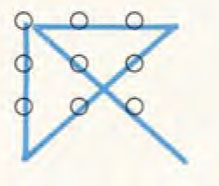A Crash Course in Paradigm Thinking
Can you cross all nine dots in the above drawing with only four straight line, without lifting your pencil from the paper? Give yourself a few minutes to try to solve this puzzle before going on to read the answer.
The puzzle is impossible to solve if you assume, like most people do the first time they see it, that there is an imaginary frame (as depicted below) around the nine dots.
This assumed border serves as a boundary, or a limit to thinking. But this imagined constraint is in the mind of the problem-solver, not in the definition of the problem.
Solving the puzzle requires us to change the paradigm, the frame of reference with which we view the problem. When we change our paradigm–our assumptions about, or the way we look at the problem–options that were unthinkable in the old paradigm suddenly emerge. The drawing below illustrates one of many solutions that become possible when we break through the assumed boundary.
The puzzle points to an important concept for success in the 1990s: We need to break out of our paradigms of thinking if we are going to solve the problems facing its.
The ability to master paradigms is a critically important skill for dealing effectively with an accelerating pace of change. A recognition of their existence is the first step toward mastering them.
Paradigm Thinking 101: Water to a Fish
The word paradigm comes from the Greek root, “paradeigma,” which means “model or pattern.” Adam Smith, in his book, Powers of Mind, defines a paradigm as “a shared set of assumptions.” Smith writes, “The paradigm is the way we perceive the world; water to the fish. The paradigm explains the world to us and helps us to predict its behavior.”
Paradigms are found in all areas of life. Futurist Joel Barker, in his book, Discovering the Future: The Business of Paradigms, defines a paradigm as “any set of rules or regulations that describes boundaries and tells us what to do to be successful within those boundaries.”
According to this broad definition, zero defects, rock and roll music and Einstein’s theory of relativity all qualify as paradigms.
A new paradigm gives rise to new possibilities. Technological advances–for example, fire, the wheel, the telescope, the steam engine, the airplane and the atomic bomb–often open the way to new paradigms.
Social paradigms dictate our behavior and collective values. In the environmental paradigm of the 1950s, the rule was “throw it anywhere, it will go away,” and smokestacks billowing black smoke were a proud symbol of productivity Medical paradigms determine how we think about our bodies. Over the years, Western medicine has identified evil spirits, humors, germs and viruses as causes of disease, and has designed treatments accordingly.
While we are in a paradigm, we take its rules and boundaries for granted. It is what we call “reality.” Like eyeglasses with colored lenses, our paradigm colors whatever we perceive.
“Most of our notions about the world come from a set of assumptions which we take for granted, and which, for the most part, we don’t examine or question,” says Werner Erhard, a consultant who has been dealing with the effects of paradigms since 1971. “We bring these assumptions to the table with us as a given. They are so much a part of who we are that it is difficult for us to separate ourselves from them enough to be able to talk about them. We do not think these assumptions, we think front them.”
Expressions such as -that’s impossible,” or “that’s not the way we do it around here” speak to the existence of paradigms, or belief systems, that are operating, unseen, in the background. Like water to the fish, they are not recognized by us as our paradigms. Yet, they influence what we think–and even what we see.
Paradigm Thinking 201: I’ll See It When I Believe it
Once we recognize that our paradigms are an invisible structure through which we think, the next step is to understand the degree to which they determine what we see and experience. Their influence is far more powerful and pervasive than we may realize.
Thomas Kuhn, who in 1962 wrote a seminal book on scientific paradigms called The Structure of Scientific Revolutions, points to an experiment that illustrates the paradigm effect. In the experiment, originally reported in 1949, people were briefly shown a deck of playing cards in which some cards had red spades instead of black. The subjects literally saw the red spades as black, because that’s what they expected. Once the anomaly was pointed out, the subjects had no trouble spotting the red spades.
The experiment and others like it led Kuhn to the conviction that our paradigms act as filters on reality. We never see the world directly; we always see it through these paradigm filters. We never see the world in its entirety; we see only pieces. And our mental frameworks naturally bias us toward only seeing that part of the world that supports our paradigms.
Paradigms act as filters on reality even in the “objective” activities of science. Kuhn found that when confronted with information that was anomalous to their paradigms, scientists either distorted the information until it fit their rules, or they just didn’t see it.
“The thing that is almost scary about the paradigm effect is its physiological impact on us,” says Barker. “We see best that which fits our rules. We see poorly or not at all that which does not.”
Paradigms Change the World
If our paradigms determine what we see, it follows that when a paradigm changes, what is seen and believed changes accordingly.
“When paradigms change, the world itself changes with them,” Kuhn writes. “Led by a new paradigm, scientists adopt new instruments and look in new places. Even more important, during revolutions [paradigm shifts] scientists see new and different things when looking with familiar instruments in places they have looked before. It is as if the professional community had been suddenly transported to another planet where familiar objects are seen in a different light and are joined by unfamiliar ones as well.”
This calls into question the notion of a fixed, objective universe. Just as an object appears differently in an infrared, ordinary-light or X-ray photograph, how reality appears to us has less to do with what is actually there than with how we are looking at it.
“Our paradigms determine the way the world ‘shows up’ for us,” says Erhard, “and that allows for only certain possibilities. Our paradigms determine our worldview, the way we perceive things, what we perceive, what we can see as possible, what we can’t see as possible and what we can’t see at all. Ultimately, they limit our strategies and our actions.”
Paradigm Thinking 301: How Paradigms Operate in Business
Adam Smith pointed out that, “When we are in the middle of a paradigm it is hard to imagine any other paradigm.” This would not be a problem for businesses if they stayed in a single paradigm indefinitely. But given the accelerating pace of change, the life expectancy of paradigms is getting shorter and shorter.
From the perspective of the current paradigm, the “obvious” future is always one that is consistent with the present and that carries forward current rules and trends. But when a paradigm shifts, the obvious and the predictable are not what occurs.
“In 1968. if you had been asked to predict who the world leader in watch manufacturing would be, you would have said the Swiss, because they had dominated the watch market for so many years,” says Barker.
Instead, there was a paradigm shift—from mechanical watches to electronic watches. The Japanese, by recognizing and acting on the new paradigm, captured the lion’s share of the market. The Swiss, by clinging to the old paradigm, steadily lost market share until they hit a low of below 10 percent during the early 1980s. Ironically, it was the Swiss who had invented the quartz watch in the first place.
This classic case serves as a textbook example of paradigm blindness. The mistakes the Swiss made because of their lack of awareness of paradigms can teach us to avoid similar pitfalls.
Back to Zero
One principle this example illustrates is that, when the paradigm shifts, all the rules change. Barker calls this the “going back to zero” rule. In the new paradigm for watches, there were no gears, no bearings and no mainspring. The technology and expertise the Swiss had for building watches in the old paradigm did not carry over to the new one.
“While a company may carry some of its leverage over from the old paradigm, there is no guarantee that it will be successful in the new game,” says Barker. “That’s why when a paradigm shifts, you see substantial anxiety. That’s why there is so much resistance to this kind of change.”
Had the Swiss known they were dealing with a paradigm shift, this recognition might have helped them overcome the universal tendency to resist change. But by looking at the history of their success, they concluded that they didn’t need to change. By staying with the old paradigm, they found themselves in the tragic condition of having to release more than 75 percent of their watch workers.
Three Phases
Another principle of paradigms is that they have three phases. Barker describes these as follows:
In the first phase, the rules are developed, expanded and refined. During this phase, we have only moderate success in solving problems with our new paradigm because we are still working out the new rules.
The second phase is the successful and productive time of a new paradigm, during which there is explosive problem-solving. The paradigm enables us to solve problems rapidly and efficiently
Eventually, the paradigm begins to run out of steam. In the third phase, the rate of problem-solving slows down. Ironically, this may be the most profitable phase of the paradigm–a fact that can blind short-term thinkers to the need for change. A build-up of the number of problems that can’t be solved, however, is a good indication that it is time for a paradigm shift.
“Every paradigm uncovers the very problems it will never solve.” says Barker.
Werner Erhard calls the phase three phenomenon the “law of diminishing returns.”
“Once you’ve established a paradigm. each move you make begins to use up that paradigm,” he says. “We try to do more of what we’ve done, do it better or do some new variation on the same theme, and we wonder why what was so great suddenly isn’t giving us the juice it once gave us. It’s because the paradigm has begun to be used Lip and we’re experiencing the law of diminishing returns.”
The Swiss, when faced with the electronic watch, did not say, “The paradigm has shifted. The old way of doing things is no longer going to work.” Instead, they tried to do “more and better” of what they had done before. By 1972, they could build mechanical watches that were accurate to a 60th of a second instead of a 30th. But measured against watches that were accurate to a 30,000th of a second, their quality improvements didn’t provide a competitive advantage.
“In the wrong paradigm, even the right actions don’t work,” says Werner Erhard.
“More effort does not produce a commensurate increase in results. No matter how smart you are or how successful you have been in the past, you can’t develop powerful strategies and effective plans when you are working in the wrong paradigm. When people begin to understand the nature and effect of paradigms on thinking and action, they can see why organizations are so often unable to duplicate the success of others or even to sustain the momentum of their
own success.
Once the third phase begins, it becomes increasingly obvious that we need to change our paradigm. But an organization that waits until the next paradigm hits it over the head is not going to maintain dynamic success.
The trick, says Barker, is to anticipate and begin to plan for the new paradigm during the successful phase of the old paradigm.
Werner Erhard goes a step further, claiming that the ability to figure out what the coming paradigm is and the flexibility to easily change are not going to be enough to ensure success in the 1990s.
Paradigm Thinking 401: Mastering the Possibilities
The successful executive of the 1990s, says Erhard, instead of merely adapting to new paradigms, is actually going to create them. Rather than taking something already in existence and putting a conceptual “fence” around it or generating new products and organizational structures from old paradigms, excellent companies will create new paradigms, which will give rise to “whole new domains of possibilities.”
That will lead to a situation in which something and its opposite are not the only alternatives. For example, Erhard points out that in trying to solve the problems of hierarchical, centralized organizations, the first thing people do is turn to the alternative provided by that model–flattened, decentralized organizations. He suggests that a different paradigm for an organization might be to look at it as a network of conversations.
“The work gets done in the openings these conversations create,” he says. “The culture of an organization is constituted by this network of conversations, which allows for certain things, pulls for certain things, doesn’t allow for certain things and makes it very difficult for certain things to emerge.”
Werner Erhard points out that this model does not fit into the prevailing current paradigm in which success is seen as a product of establishing clear-cut goals.
“Rather than imposing goals on organizations and managing to narrow people’s actions toward the achievement of those goals, the excellent business leaders of the 1990s will establish organizations in which there will be a lot more freedom for people to actually be proactive and entrepreneurial and self-generating. Excellent managers in the future will be clear about their power to establish realms of possibility and about their ability to empower and enable people to be effective in those realms.”
And, he adds, there will be a higher degree of productivity from team-building project commitments (see sidebar story below) than from conformity or elimination of those actions that don’t lead straight to the goal.
“What hasn’t been recognized is that there is an enormous amount of new possibility, an enormous amount of room for creativity, innovation and for new levels of productivity in new paradigms,” says Erhard. “Great executives are those who can create new possibilities for people to work into and to fill up with accomplishments.”
Paradigm Thinking Post-Graduate Course: Inventing the Future
What great executives will do in the 1990s, says Erhard, is to create different paradigms that are appropriate to the commitments in various parts of the organization.
“They will be able to shape organization-wide paradigms that are appropriate to the moving sands, changing markets, changing competition and introduction of new technologies,” he says. “As fast on its feet as an organization is today in changing its focus, that’s how fast it will have to be to be able to change the paradigms in which those focuses are developed.”
Werner Erhard says that instead of waiting for a new paradigm to become apparent, we can create and invent futures that “were not going to happen anyway.”
“The most interesting part of management is the part that’s committed to what wasn’t predictable, to what wasn’t going to happen,” says Werner Erhard. “That’s what people get paid a lot of money for.”
The Metaphysics of Paradigms
The secret of paradigms is that, with them, we construct our own reality. As Thomas Kuhn said in 1962: “When paradigms change, the world itself changes with them.”
It’s a revolutionary thought, and it is the most important thing to know about paradigms.
How reality occurs–or “shows up”–for people is not determined by what’s there to be seen, but by how we are seeing it.
“We know very little about the real rules of the world, what can and cannot be done and what is and is not possible,” says Barker. “But we can choose to see the world in new ways.”
In so doing, we will–literally–change the world that is there for us to see.
from the Fall 1989 issue of Benchmark Magazine, a publication of Xerox Corporation



